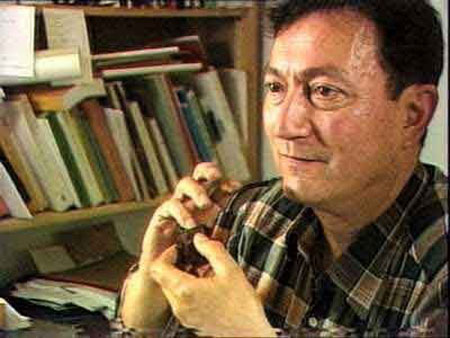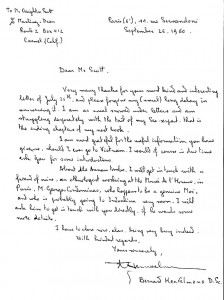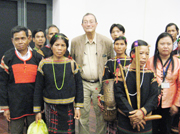Georges Condonminas Dies
Posted by: Loren Coleman on July 31st, 2011

Georges Condominas (1921 – 2011) was a French cultural anthropologist and friend of the late cryptozoologist Bernard Heuvelmans. He died overnight from Saturday July 16, to Sunday July 17, 2011, from a heart attack at the hôpital Broca in Paris, where he had been a patient for some time. He is best known for his field studies of the Mnong people of Vietnam, and may have gathered valuable material on the “rock apes” or Người Rừng of Vietnam.

The letter in which Heuvelmans mentions his friendship with Condonminas, from 1960. Credit: Chad Arment.
Georges Condominas was born in 1921 in Haiphong (former French Indochina, Vietnam today). His father was a French officer in the colonial army and his mother has Chinese, Vietnamese and Portuguese roots.
Georges Condominas attended a high school in the South of Paris, the Lycée Lakanal, but kept in touch with his father through letters and photographs. After he graduated, he started studying law in France. Then he returned to Indochina to work in the colonial administration but ended his job to study art in Hanoi. During the Japanese occupation he was a prisoner at the Mikado Hotel.
After World war II, he began to study ethnology and returned to France to follow the lectures of the famous professors of the time, including André Leroi-Gourhan, Denise Paulme and Marcel Griaule at the Musée de l’Homme, and Maurice Leenhardt at the École pratique des hautes études in Paris.
One of his first ethnologic fieldwork experiences was in the Vietnamese village of Sar Luk in the province of Dac Lac. From this experience, he wrote two books:
- The first is entitled We have eaten the forest in 1957. It is noticed by Claude Lévi-Strauss and Edouard Glissant for its literary qualities.
- The second one is entitled L’exotique est quotidien (1965) but hasn’t been translated into English so far.
In 1960, he became a professor at the École pratique des hautes études in Paris and created the CeDRASEMI, a French research center focused on South East Asian and the Insulindian world, in 1962.
Condominas then became a visiting professor at Columbia University and Yale University between 1963 and 1969. He was a Fellow of the Center for Advanced Studies in the Behavioral Sciences of Palo Alto in 1971. He was chosen in 1972 for the Distinguished Lecture of the annual session of the American Anthropological Association, where he denounced the Vietnam War and the ethnocide of the Mnong. He was a close friend of Margaret Mead, John Embree and Elizabeth Wiswell Embree. He was considered as an expert ethnologist in Japan, where he was the first foreigner ever to deliver a speech at the Nihon Minzoku Gakkai, a Japanese anthropological association, for its 50th anniversary.
He was also invited to the Australian National University in 1987 and to the Japanese university of Sophia in 1992.
His work inspired many books and movies. The record he made of the Mnong music can be heard at the end of Francis Ford Coppola’s Apocalypse Now, the final scene of which was inspired by Condominas’s description of the ritual slaughter of buffalo.
In 2006 the Vietnam Museum of Ethnology cooperated with the French-owned Quai Branly Museum to organize an exhibition devoted to Condominas and his field work in central Vietnam. The exhibition was also presented the next year, in 2007, in Hanoï, Vietnam, with a bilingual catalog. Today, his working papers, his personal library and his pictures are preserved at the mediatheque of the Musée du quai Branly, available for scholars and researchers.
Besides his work in Vietnam, the anthropologist also conducted studies in Thailand, Laos, Cambodia, and Japan.

Books
- Nous avons mangé la forêt de la Pierre-Génie Gôo (Hii saa Brii Mau-Yaang Gôo). Chronique de Sar Luk, village mnong gar (tribu proto-indochinoise des Hauts-Plateaux du Viet-nam central), Paris, Mercure de France, 1954 (2nd edition 1974, 2003; paperback edition Flammarion, 1982; transl. Italian, Milan, 1960; Russian, Moscow, 1968; German, Frankfurt, 1969; English, New York, Harmondsworth, 1977 and republished New York and Tokyo, 1994; Japanese, Tokyo, 1993; Vietnamese, Hanoi, 2003; Hungarian, Budapest, in preparation).
- L’ Exotique est quotidien, Sar Luk, Vietnam central, Paris, Plon, 1965 (Collection Terre humaine) (2nd edition 1977; transl. Spanish with preface by Manuel Delgado, Barcelona, 1992).
- Fokon ‘olona et collectivités rurales en Imerina, preface by Hubert Deschamps, Paris, Berger-Levrault, 1960, 234 p., cov. ill map; bibliog. p. 23 1-234 (L’homme d’Outre-Mer. Nouvelle série. 3) (2nd edition ORSTOM, 1991).
- L’Espace social. A propos de l’Asie du Sud-Est, Paris, Flammarion, 1980 (transl. Vietnamese, Hanoi, 1997). Republication underway by Editions Les Indes savantes.
- From Lawa to Mon, from Saa’ to Thai: historical and anthropological aspects of Southeast Asian social spaces, transl. by Stephanie Anderson, Maria Magannon and Gehan Wijeyewardene, Canberra, Department of Anthropology, Research School of Pacific Studies, Australian National University, 1990, VI-114 p., ill., maps, plan, photographs; glossary (An occasional paper of the department of anthropology, in association with the Thai-Yunnan project).
- L ‘Espace social = Raya thaang sangkhôm, Bangkok, Cahiers de France, 1991 (transl. Thai by Chatchada Ratanasamakarn and Sumitra Baffie).
- Le Bouddhisme au village = Val sonna bot: notes ethnographiques sur les pratiques religieuses dans la société rurale lao (plaine de Vientiane), Vientiane, Cahiers de France, 1998 (transl. Laotian by Saveng Phinith).
Editorship of collective works
- Agriculture et societies en Asie du Sud-Est, Etudes rurales, 53-56, Jan.-Dec. 1974 (co-edited with J. Barrau, L. Bernot and I. Chiva).
- L’Anthropologie en France: situation actuelle et avenir. Acts of the international colloquium organized at the CNRS by G. Condominas and S. Dreyfus-Ganielon, 18–22 April 1977, Paris, CNRS, 1979.
- Disciplines croisées: hommage à Bernard Philippe Groslier, Paris EHESS, 1992 (co-edited by D. Bernot, M.-A. Martin and M. Zaini-Lajoubert).
- Les Réfugiés originaires de l’Asie du Sud-Est: rapport au Président de la République, Paris, La Documentation française, 2 vol. 1982-1984 (CeDRASEMI collective report, edited in collaboration with R. Pottier, duplicated in 1981).
- Formes extrêmes de dépendance: contributions à l’étude de l’esclavage en Asie du Sud- Est, Paris, EHESS, 1998 (co-edited with M.-A. Martin and J. Ivanof).
Filmography
- Sar Luk: les travaux et les jours d’un village mnong gar du Vietnam central, film directed by Georges Condominas and Aiain Bedos based on photos, sung poems collected between 1948 and 1950, and music recorded in 1958 and 1984 (English version translated by Maria Pilar Luna-Magannon).
- [Sar Luk: toils and days of a Mnong Gar village in Central Vietnam: [synopsis], transl. by Maria Pilar Luna-Magannon, film, CNRS-CeDRASEMI, 1984, 14 ff. dact.]
- L’Exotique est quotidien: retour à Sar Luk, directed by Jean Lallier, 16:9 digital telefilm, 16:9 satellite broadcast by France Télévision, VHS videocassette, 52 min., Paris, ADAV / Europe images, Les Films d’ici, Paris, 1996, broadcast by France 2, 1997.
- Nous avons mangé la forêt…, film directed by par Georges Condominas and Jean Lallier, VHS videocassette, 80 min., Le Vidéographe, Université de Toulouse-Le Mirail / Les Films d’ici co-production, 1999.
- Le Sacrifice du buffle, film directed by Georges Condominas and Jean Lallier, VHS videocassette, 50 min., Le Vidéographe, Université de Toulouse-Le Mirail / Les Films d’ici co-production, 1999.
Discography
- Musique mnong gar du Vietnam (anthologie de musique proto-indochinoise, vol. 1), Paris, OCORA, 1974, 30 cm LP, text by G. Condominas, 10 p. in French and English, notes and bibliog., 12 black-and-white photos, 1 color photo, 1 map (Musée de l’Homme collection, OCORA OCR 80/ ORTF).
- Vietnam: musique des montagnards, le Chant du Monde, CNR 2741085.86, 1997 (Collections of the CNRS and the Musée de l’Homme) [CDI, Jörai (1), Lac (14, 15, 16); CDII, Khmu, 1973 (19, 20, 21)].
About Loren Coleman
Loren Coleman is one of the world’s leading cryptozoologists, some say “the” leading living cryptozoologist. Certainly, he is acknowledged as the current living American researcher and writer who has most popularized cryptozoology in the late 20th and early 21st centuries.
Starting his fieldwork and investigations in 1960, after traveling and trekking extensively in pursuit of cryptozoological mysteries, Coleman began writing to share his experiences in 1969. An honorary member of Ivan T. Sanderson’s Society for the Investigation of the Unexplained in the 1970s, Coleman has been bestowed with similar honorary memberships of the North Idaho College Cryptozoology Club in 1983, and in subsequent years, that of the British Columbia Scientific Cryptozoology Club, CryptoSafari International, and other international organizations. He was also a Life Member and Benefactor of the International Society of Cryptozoology (now-defunct).
Loren Coleman’s daily blog, as a member of the Cryptomundo Team, served as an ongoing avenue of communication for the ever-growing body of cryptozoo news from 2005 through 2013. He returned as an infrequent contributor beginning Halloween week of 2015.
Coleman is the founder in 2003, and current director of the International Cryptozoology Museum in Portland, Maine.









